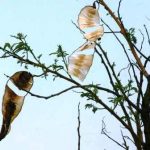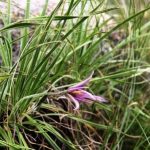TREE LIFE
NOVEMBER 1992
MASHONALAND CALENDAR
Tuesday 3rd November : Botanical Garden walk at 4.45 for 5 pm. Park at the Herbarium where we will meet Tom Muller.
Saturday 15th November : Uronga South Bindura. We’ve been looking forward to this trip since Rob Paré introduced us to butterflies some months ago. Rob who has studied butterflies since he was a young boy has planted many species of indigenous trees, on his farm to enable him to observe these beautiful creatures in as natural a habitat as possible. Bob will lead us through his ‘plantation” and will be happy to answer our questions. In the course of the day we will go down to the Mazowe River meeting up with Garth Snook our joint host. As this will be a very full and interesting day we will meet at the homestead at 9.30 am. We are grateful to Bob for his article “Insect – Plant Relationship” – the perfect introduction for the outing.
Saturday 28th November : Mark will lead a walk around the Avondale Parkland which from King George Road is left off Natal Road into Lincoln Road. We will meet at 3 pm at the sub/station which is on the left about 300 meters from the Natal/Lincoln crossroad.
Tuesday 1st Decembeer : Botanical Garden walk
Sunday13th December : Christmas social Mukuvisi woodlands.
MATABELELAND CALENDAR
Sunday 1st November : All day visit in the Matopos. Before lunch we will follow the Gun Carriage Route from Lower Outspan to the grave, and in the afternoon will botanise in the Whitewaters area. Rendezvous at Retreat Shopping centre for the usual 0830 hour departure.
Monday 9th November : The Urban Trail. We meet at Hillside Dams at 1500 hours
Sunday 6th December : Visit to Peter and Jenny Parsons farm and their new safari camp Ntabazinduna Lodge. We will be doing a tree survey for them. It is a morning outing so bring tea and chairs. Rendezvous at the City Hall car park for an 0830 hour departure and a trip which promises trees, game and spectacular views.
Monday 14th December. The Urban Trail at Hillside Dams at 5pm.
MEETING OF THE TREE SOCIETY HELD ON SEPTEMBER 13TH 1992 AT THE RESIDENCE OF MR AND MRS D. VILJOEN
On September 13th a joint meeting with the Mabukuwene Aloe Society was held at Derek and Barbara Viljoen’s house, addressed by Mr Brian Schlachter. The speaker is a man with a mission, an agronomist by profession, he applauds all efforts at conservation, but his particular enthusiasm is the propagation of Cycads by gardeners and horticulturists so that the populations of the five species of Zimbabwean cycads can be restored and maintained. These species are
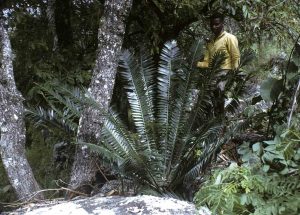
Encepalartos manikensis. Photo: Darrel Plowes. Source: Flora of Zimbabwe
(a) Encepalartos manikensis distributed from the Chimanimani Mountains north through the Stapleford Forest area and Mount Darwin, and adjoining areas of Mozambique.
(b) E.chimanimaniensis – found in a restricted area near to Martin Falls.
(c) E.manchei a restricted population on Mt Zerbe near Chimoio in Mozambique.
(d) E.pterogonis also near Chimoio.
(e) E. coninus — endemic to Zimbabwe, occurring in rocky, granite kcpjies in the Belingwe, west Nicolson and Runde River area.
Regrettably, a recent upsurge of interest in Cycads and the profitable market for them as garden plants has resulted in the wholesale removal from their natural habitat of many of the more accessible populations. Their present owners probably do not know where their plants came from originally.
Cycads belong to an ancient order of plants which 250-200 million years ago covered vast areas of a warm, humid earth. The coal beds were already formed by this time, but flowering plants were only beginning to appear. Probably 150 Cycad species survive today, about half of these, including the Zimbabwe ones, being classified as “endangered” and the subject of protective legislation. Many species are the result of successful adaptation to changing environmental conditions, so Cycads should not be regarded as fossil curiosities.
Cycads are Gymnosperms, i.e. plants that bear naked seeds. These develop in the cones of female plants after pollen is carried by wind from a nearby separate male plant; fertilization of the ovule may then take place provided the female cone was at the 10 day period of ‘receptivity’. Simultaneous ‘coning’ of male and female plants is crucial to successful reproduction. This is clearly more likely to occur in a large dense population than in one decimated by the greedy hand of man.
Today, conifirs, also Gymasperms, make up a substantial proportion of the world’s forests, but flowering plants, notably grasses and trees are now the dominant flora . The evolution of flowers has enabled insect (also bird and bat) pollination and the enclosing of seeds in a fruit led to a variety of dispersal mechanisms and afforded protection for predation. Pollen grains with a larger food store and capable of directional growth within the flower increase fertilisation success rates.
To encourage his listeners to participate in Cycad growing, Mr. Schlacter gave detailed advice on :
(1) recognition of Zimbabwean species and their gender;
(ii) collection and storage of pollen;
(iii) recognition of ‘receptivity’ in female cones;
(iv) technique of hand pollination;
(v )collection of seeds ( + – 7 months later) and testing for viability;
(vi) propagation by seed and care of seedlings (patience) the first leaf will only appear six weeks after germination, the initial growth producing a large, parsnip-like tap root. 8 months may now elapse before a second leaf appears;
(vii) cultivation of cycads in pots with subsequent planting in open ground (more patience) enthuse your children and your children’s children . The gender of your plants will only be revealed when they are 15-25 years old and they will then cone every 2-3 years,
(viii) nutrient needs throughout the life history: a female cone containing several hundred viable seeds will weigh up to 15 kg the parent plant needs feeding!
Not everyone will agree that an isolated Cycad is a desirable garden subject, but fascinating certainly and worth protecting from extinction in habitat. Hopefully, some of Mr S’s listeners will have the facilities to respond positively to the challenge he posed with such enthusiasm and urgency.
PS The place of Cycads in plant evolution and the possibility of propagation by tissue culture are discussed in two articles by Roy Osborn in Excelsa No. 12. The gender of a particular plant has been known to after some trauma, presumably brought about by an impact in the sex hormone balance. Who knows – “test tube babies” may yet be the way ahead for Cycads.
-ALISON EWEBANK .
BOTANIC GARDEN WALK 6 OCTOBER 1992
A good number of Tree Society members gathered at the Herbarium on Tuesday evening for a walk led by Tom Muller. We generally looked at floral characters, which as Tom pointed out are what are used in determining the classification of plant species into order, families, genera etc.
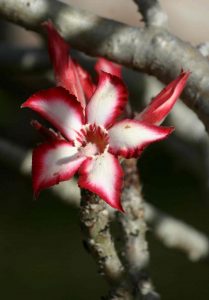
Adenium multiflorum. Photo:Bart Wursten. Source: Flora of Zimbabwe
At a fine bed of the Sabi Star, Adenium multiflorum we examined the floral parts and in particular the long twisted stamens. There was a certain amount of confusion here as the stamens appeared to lack anthers. However, we eventually sorted out the structure and the considerably shorter stigma was located. A very striking feature of this species and some other members of the family APOCYNACEAE is the paired capsules. These were large and were held at an angle of almost 180 degrees to each other. Later we saw Rauvolfia caffra and Carissa bispinosa, both of which belong to this same family, but both of which have simple fruits.
On to Rothmannia manganjae, a forest species of the RUBIACEAE with white corallas with purplish blotches. Tom mentioned that the fruit takes two years to ripen, so that at any one time there are two series of ripening fruit on a particular tree; the first year fruits are green, the second year’s brown. Tom has eaten the fruit many times but the last time was ill afterwards – was this a coincidence? The inferior ovary and the long-exserted style noted. A nearby Rothmannia urcelliforumis was in bud only.
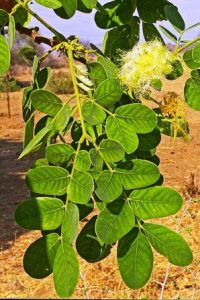
Albizia schimperiana. Photo: Bart Wursten. Source: Flora of Zimbabwe
A very lovely flowering tree of Albizia gummifora was also examined in detail. The shaving brush inflorescences are a mass of individual flowers. The inner ones have a sterile starflower in the middle which serves to distinguish this species from Albizia schimperiana which does not. Nearby was Kigelia africana, the Sausage Tree. Its large dark red flowers grow in hanging inflorescences and are bat pollinated.
The strange Trichocladus ellipticus had finished flowering so we were not able to experience the powerful scent. This belongs to the Witch-hazel family (HAMAMELIDACEAE). True Witch-hazel belongs to the genus Hamamelis and is an early spring flowering species in Europe.
Of some interest was a Macadamia tree, with leaves in whorls of fours and fives.
We gathered that Macadamia is the generic name. The flowers were reminiscent of Faurea in the same family (PROTEACEAE).
Later, in the fading light in the darkening forest section we briefly paused before
a Tabernaemontana ventricosa. Another APOCYNACEAE, its two relatives the Toad Tree
T.elegans and the Soccer ball Tree (T.staphiana) are perhaps better known. This genus has paired fruits, but one may abort, thereby possibly causing confusion.
Once again, our thanks to Tom for an exciting botanical session in the Botanic Gardens.
-Mark Hyde
INSECT – PLANT RELATIONSHIPS – Rob Pare
Virtually every species of butterfly or moth worldwide depends on the leaves of one plant or another as food for it’s developing larvae. A few species utilise either flowers, fruits or seeds, some bore into the stems, some exist on various algae, and some are even carnivorous, but that is a subject all on its own.
There is virtually no plant anywhere that does not bear evidence of having had part of it eaten by some insect or other. There are many recorded relationships between plants and insects, but those we know nothing about must run into millions.
I have been studying the life histories of the Zimbabwean butterflies for several years, so my observations are restricted to that field.
Some of our butterfly species are dependent on single plant or tree species for their larval food, while others are able to utilize two or more species. It is very significant that where additional plant species are used, they are usually quite closely related — some genus or same family. Certain butterfly species are able to utilise a very wide range of plants. The Painted Lady (Vanessa cardui) is a good example of this ability, and is found almost anywhere in the world where there are butterflies as a result. At the extreme, some butterfly species occupy very restricted ranges, sometimes as little as one or two hectares, although to be fair, climatic and geographic factors often are part of the cause. The presence of a particular butterfly species in an area is usually an indication that its food plant also occurs there. [The converse doesn’t necessarily apply, as climatic factors sometimes restrict range in spite of wide ranging food plants. A good example of this is the beautiful Flame bordered Charaxes, Charaxesprotoclea_azota, which uses both Brachystegia spiciformis and_Afzelia quanzensis, and yet is restricted to a fairly narrow strip along the moister Eastern Highlands. Another Charaxes species C.guderiana turns up fairly often along the Zambesi River around Chirundu, at least 30 kilometres from the nearest Brachystegia and Julbernardia on the Escarpment which are its known food plants. Occasional individual could certainly fly that distance, but the regularity of its occurrence and the fresh condition of specimens taken at the river indicate that it is using an as yet unknown tree there. I’m assuming it will be a tree as the charaxes almost without exception use trees or their saplings. Knowing that it will most likely be a tree fairly close to the known ones. Tamarindus indica is my guess or possibly Cordyla. I have both of these growing at home, so it will be a fairly simple matter to trap a live female and sleeve-net her on a spray of fresh foliage, where she will lay her eggs if the leaves give her the correct signals. If not, we scratch our heads and try again – Dalbergia or maybe Xanthocercis?
This brings us to the really interesting bit. Leaves of almost any plant any where in the world contain all the nutrients that any caterpillar needs for growth. The implications of that fact are potentially catastrophic for this planet, all plant life would have been guzzled out of existence long ago if it were not for the control mechanisms built into insects. Lets examine briefly how a female butterfly locates the food plant in order to lay her eggs. Firstly, the air temperature must be at a reasonable level – at least 25°C. The female first detects the presence of the required plant with her antennae, picking up the minute traces of volatile essential oils as they are known, given off by the plant into the surrounding air. Once she has located it, she flies through and around the foliage, alighting every so often to check the suitability of the leaf, via special sensory organs in her feet, known as chemoreceptors which must give here the correct signals if she is to continue.
The age of the leaf is important here, as most species can only use fairly young to mature materal. Dust on the leaf surface will usually make the female reject that plant and move on as will various repellant substances like ethylene which the plant emits when it is already being fed upon by caterpillars. Once the chemorecptors in the feet and others at the tip of the abdomen have been satisfied, egg laying begins. Somehow the butterfly has gauged the size of the food plant and will only lay a few eggs on if before moving on to seek out others. The dispersal seems to be beneficial to both parties, as the plant is not over grazed and the predators and parasites have a hard time finding the larvae. The abundance of any particular food plant seems to have very little bearing on the population level of the butterfly species which feeds on it. Julbernardia globiflora is a good example. It is arguably the most common and most widespread of all Zimbabwe’s trees, and is knowm to be the food plant of at least 11 different butterfly species, none of which is particularly common. In all my wanderings in the bush, I have seldom come across larva of more than one species on an individual Julbernardia globiflora. It seems to be a case of first-come-first served . Once the eggs hatch, the larva usually eat their egg shells as their first meal before starting to eat the foliage, which must now pass a further series of chemoreceptors in and around the mouthparts. Firstly, small 3-segment antennae either side of the jaws must satisfy the larva that the food is the correct one. Then tiny sensory palps must also be satisfied. Interestingly, the surgical removal of these palps has resulted in the larva happily eating almost any type of leaf material offered. As if that were not enough, a final set of chemoreceptors is at the beginning of the digestive tract, and they cause a violent reaction if offended, causing the larva to vomit up all it has eaten.
In the wild, the larval chemorecepturs are largely a formality, but when one comes to introduced plants of similar genera to local ones although the finale butterfly may be fooled by them, the larvae seldom are.
I have done some interesting experimentation where, although a female cannot be induced to lay on a plant closely related to her usual food plant, her offspring, transferred as eggs, have no choice but to eat the new plant, and it often passes their test, even having failed their mother’s .
While searching patiently a few years ago for larvae of the then unknown Charaxes chittyi (recently named after the late J.C.O. Chitty of Harare), I noticed something very interesting. I had seen females of that species showing more than a passing interest in Brachystegia boehmii and decided that mist be its food plant. In an area where at least 50% of the trees were B.boehmii, it was a long drawn out search, which was eventually rewarded by the discovery of a few larva, which did eventually turn out to be C.chittyi.
During the search, I had noticed that the very occasional tree had smooth (glabrous) leaves instead of the usual hairy ones, and it eventually dawned that larva had only been found on these glabrous ones. Thereafter the search became easy, as I only needed to feel the leaves to know whether to search or pass on to the next tree. I tried to feed hairy leaves to some of the larva and they reacted so violently that I might as well have fed then DDT . It was lethal to them – can this just be the hairs, or is there a significant chemical difference in the leaves? I have been able to force females to lay their eggs on the hairy 1eaves, but the larvae were unable to eat them. I have noticed a similar situation with different butterfly species on Dichrostachys cinerea where the subspecies is nyasana with its hairless leaves supports larvae while spp. africana cannot, and yet another on Ficus sur, where only the occasional glabrous specimen will support larvae of the Map butterfly (Cyrestis pantheus) whose life history has only recently been discovered.
As an interesting aside, in April 1992, I took a walk in the Fuller Forest just south of Victoria Falls, and found that the Brachystegia boehmii there are almost without exception all Glabrous leaved. I don’t think Charaxes chittyi has discovered this situation yet! Unfortunately it was the wrong time of year to collect seed; those that I have carefully collected at Bindura off glabrous trees and germinated here have produced hairy seedlings much to my frustration!
One final interesting observation, by no means exhaustively researched, but nonetheless significant, is the fact that of the 35 families of the National Tree Iist (Drummond 1981),only 31 contain species that are known to be food plants of butterfly species. Many life histories are yet to be discovered so there is an incredible amount of work to be done. Worldwide literature is full of clues for us – for example the Map butterfly just mentioned has related species in South America and the Far East, but no relatives in Africa. Those relatives whose life histories are known are dependant on various MORACEAE which gave the clue to where to start looking here. Examining saplings of Triplepisium madagascariensis in Chirinda Forest led to the discovery of very strange larvae which turned out to be those of C.pantheus – a great thrill. Since this species occasionally turns up hundreds of kilometres away from its home habitats in the Eastern districts forests, we assumed it would also be using a Ficus species, and F.sur proved to be the one, although only the glabrous individuals. The possibility that other Ficus species are also used is very real, only time and search will reveal it, and such discoveries are their own reward.
HUNTSMAN INDIGENOUS TREE NURSERY – OCTOBER 1992
The story of October’s visit goes back five months to the wonderful weekend we shared with Harare dendrophilos at Good Hope Country Club in May. On our first night there I was introduced to Kathy Williams who gave me a broadsheet advertising an open day at “Huntsman Indigenous Trees” the following Saturday. In due course we attend and were deeply impressed by all that we saw and heard. Since Turk Mine is only some fifty kilometres north of Bulawayo, we thought that Matabeleland members might enjoy a visit, especially in the leafless month of October.
The nursery is the brainchild of Brian Williams, son of Kathy and Phil. He is something of a polymath – an artist, a cabinet maker, a philosopher and now a woodman. He initially started a nursery in Harare out of concern for the dwindling supply of fine wood for his craft and out of a profound uneasiness over modern forestry practice in Zimbabwe.
‘The Woodman‘ or land owner from generations past might well be impressed with a 1992 plantation of Eucalyptus grandis, however the absence of ‘venison or fowl‘ in this forest would not escape a trained hunting eye‘. The wisdom of the past was not necessarily being superseded by future trends.
Here in Zimbabwe, together with other countries of this region, we have an odd assortment of forestry practices being carried out simultaneously. Zimbabwe is host to many good African hardwood tree species, a tremendous variety of which covers our region. Our Plantation Industry has been highly successful in growing entirely exotic species. Our Forestry Commission is well respected as a Eucalyptus breeder. However, we have yet to start on the indigenous plantations. Little in the way of comprehensive trials of valued hardwoods has been carried out in Zimbabwe. Amongst the many varieties found here no candidates appear to have been considered worthwhile. Despite this extensive logging operations on certain species have been carried out during the past century. The adopted policy for timber extraction is to cut within a ‘Concession Area’ all mature specimens of a species, the remaining trees being those protected by the ‘Girth Regulation.‘ Unfortunately, this has resulted in the loss of some of the best genetic material.”
This short extract from Brian William’s paper on “Indigenous Forestry“ gives not only an insight into his holistic philosophy, but also explains what has happened since the early days of the project. An industry such as this must be backed by an extension service based on sound research and this is the track that Brian has now taken. Much of his time is devoted to field trials and research and the management of the nursery, now relocated at Turk Mine on the family farm is in the very capable hands of Cathy Williams. Revenue from the latter operation now finances much of Brian‘s pioneering research.
In the nursery the plants are raised from the seed material of specially selected parent trees. Documentation is particularly thorough and one can for any given group discover its batch number and planting dates and, depending on the species, one’s purchase options range from three months seedlings to two year old saplings. Prices rise with age.
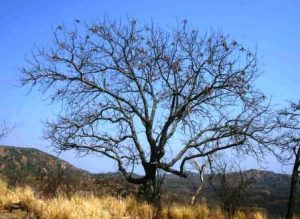
Entandophragma cordatum. Photo: Bart Wursten. Source: Flora of Zimbabwe
Interest in the nursery has grown rapidly in recent months. Elephant Hills has purchased over a thousand trees to replace those which were destroyed during their current building operation at Victoria Falls. A Midlands farmer is planning to grow a “forest” of Entandophragma cordatum and the Lutheran World Federation has an order running into thousands which is part of their re-afforestation programme in Matabeleland. Not to be outdone, the William’s themselves are thinking seriously about growing a Newtonia buchananii forest at Turk Mine – under irrigation of course.
The catalogue for April 1992 gave a selection of 70 species and the July one showed 86 species. Such is the pace of things at the nursery.
In an hour and a half perambulation through germination beds and shade houses, Kathy gave us a most comprehensive lecture on the propagation of the large range of indigenous trees on the Huntsman catalogue. We finished the morning with tea and cheese muffins on a lawn in the shade of an Acrocarpus.
-IAN McCLAUSLAND
NYARUPINDA CATCHMENT – October 1992
A holiday in temperate climes was refreshment for body and mind, here are some gleanings collected on route. The first comes from a book published in New Jersey U.S.A. for users of wood burning stoves. There is a quotation by Henry James Thereau who challenged man’s values and ways of living in his finest book “Walden” (1854), in which he describes the joys of living alone for two years in a wooden but of his own building in the woods near Walden Pond, Concord, Massachusetts. He was a writer, a philosopher and notable ecologist.
“wood warms you twice, once when you cut it, and again when you burn it.” Ode to a Wood burner
Beechwood fires are bright and clear, if logs are kept a year.
Chestnuts only good, they say, if for long its laid away.
Birch and Fir logs burn too fast, blazing up bright and do not last.
Elm wood bums like a churchyard mould, even the very flames are cold.
Poplar gives a bitter smoke, fills your eyes and makes you choke.
Apple wood will scent your room with an incense like perfume.
Oak and Maple if dry and old, keep away the winter cold,
But Ash wood wet and Ash wood dry, a king shall warm his slippers by.
Aromatherapy for Men
Aromatherapy is about renewal and vigour, to improve memory and aid concentration. To achieve this the Romans used sprigs of Rosemary behind the ear that would be a novelty in today’s office. How about this essential oil being used on the blotting paper (not quite obsolete) to charge the atmosphere in any work environment. Especially masculine oils are Rosewood, Lemon, Frankincense and Cypress. The leaflet on aromatherapy goes on to say that ‘combined with a healthy diet and sensible exercise, aromatic essential oils can be considered valuable in helping you meet the crises and changes of middle age’ the hesitant may be persuaded to enjoy the effects of a mixture of Lavender and Frankincense in the bath or in a massage oil blended with carrier oil. There you are, take it or leave it, it is rather tempting. Cypress is invigorating, sandalwood soothes.
The scene : September 22nd was the day of our return from the UK. It was very hot and windy which augured well for the build up towards the rains, October so far has not worm the ‘cloak of listlessness which we expect, it has been too windy. The colony of more than 30 fruit bats, which spent winter days at the top of a Mfuti which shades the house, have departed after a happy co-existence with us, perhaps the gales disturbed them.
In October the Fiery necked Nightjars and a solitary plover call, then silence, broken by a short burst of sound from a Mozambique nightjar. Today is October 7th a pair of Bennett’s woodpeckers have made delightful resonant notes because the inside of a natural hole in a Munondo tree is being enlarged. This event had been a compelling distraction whilst writing this because the tree is opposite my work room. Paul Zwanniken confirmed my cursory observation that the pair seemed to share the work of hole making. No sooner than one bird had inspected the hole another came out of it.
Tomorrow, Paul is coming to see them and also to see what makes the tiny lights on the winter twigs of Ehretia obtusifolia. These were first seen against the sunset during the middle of August. Sunlight shone through a drop of gum at the base of every dormant bud… food for thought… to attract ants to protect the unfolding buds? to prevent desiccation?
To return to the birds, mid-morning work began, the labourer was the male, when he emerged to search the branches, the female arrived and was seen to bring the rubbish piece by piece (some of it was difficult to remove from her beak) out of the hole, sometimes she had to peck, (less noisily than her mate) to loosen a bit of debris which she brought to the top of the excavation), with a toss of her beak it was gone; later, unobtrusively, we will see what she has thrown out. Apart from her red hindcrown the female Bennett’s woodpecker resembles the shadowy sunlit bark of Julbernardia globiflora.
Now it is as if the woodpeckers had never been here; the debris from the hole consisted of wood chips some of which were black and shiny others were the colour of normal heartwood.
Protea Flowers
Tony Rebelo in the Botany Department of the University of Cape Town promptly sent up heaps of information on the structure and pollination mechanism and role of pollinating agents of the PROTEACEAE. This will feature in the Protea Atlas Newsletter No. 17. At the moment the most recent P.A.N. is No. 15; it appears quarterly. In the meantime a rough draft of the article complete with amusing botanical illustrations was included with a Protea Atlassing kit for me! Perhaps, before long, someone in Zimbabwe will fill in a Site Record Sheet ahead of Swaziland and be the first Atlasser outside the Republic of South Africa.
Civetries : Inspections of those near the vlei revealed wads of mammal hair of various colours, no different species of seeds, which needed identification. The dung heap on the stoney hillside below the house contained brittle pieces of tree gum, stones, wads of coarse grass and a claw – complete with skin and fur.
-Benadicta Graves
GEORGE HALL CHAIRMAN


